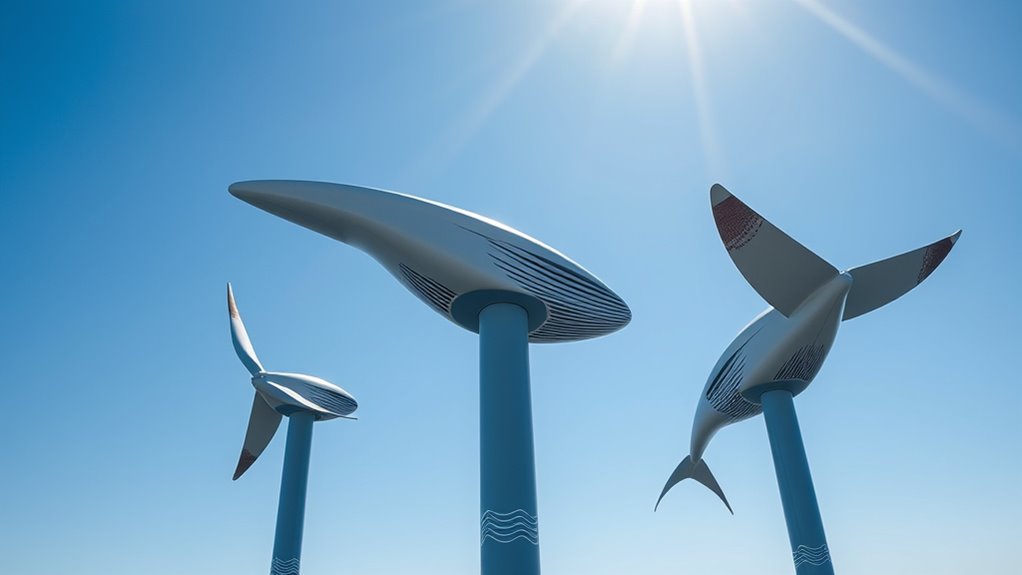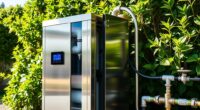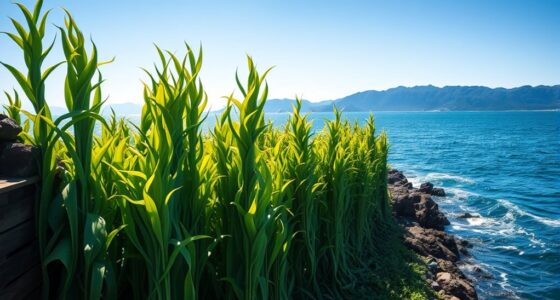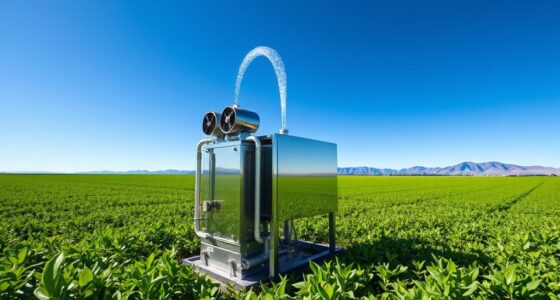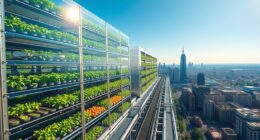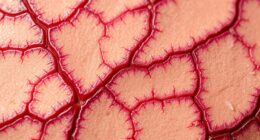Bio-inspired wind turbines modeled after humpback whales incorporate tubercle features on blade edges to improve efficiency. These bumps help delay stall, increase lift by around 8%, and cut drag by roughly 32%. By mimicking whale flippers, the turbines perform better, especially in turbulent winds, and operate at higher angles of attack. If you keep exploring, you’ll discover how these natural designs can revolutionize renewable energy technology.
Key Takeaways
- Bio-inspired wind turbine blades incorporate tubercle-like bumps based on humpback whale fins to improve lift and delay stall.
- Tubercles create channels of fast-moving water, reducing drag by approximately 32% and increasing lift by around 8%.
- These designs enable turbines to operate efficiently at higher angles of attack, enhancing performance in variable wind conditions.
- Wind tunnel tests show that tubercle-inspired blades extend operational range and reduce turbulent vortices at blade tips.
- Industry leaders like WhalePower develop turbines using whale-inspired tubercle technology to increase energy capture and sustainability.
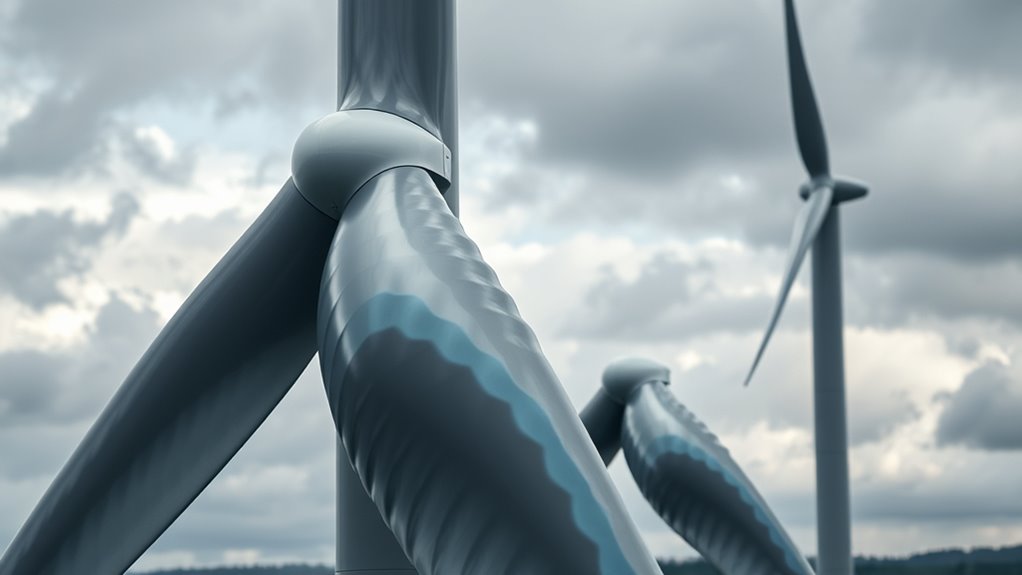
Have you ever wondered how studying nature can lead to more efficient renewable energy solutions? The answer lies in biomimicry—drawing inspiration from the natural world to improve engineering designs. One of the most fascinating examples involves humpback whales and their flippers. These marine giants have unique flippers adorned with irregular bumps called tubercles along their leading edges. These tubercles form a saw-like profile that plays an essential role in water flow management. When water flows over the flipper, the tubercles create channels of fast-moving water, which delay stall and reduce drag compared to smooth-edged fins. This design doesn’t just improve maneuverability for whales; it also boosts lift by approximately 8% and cuts drag by around 32%. Remarkably, flippers with tubercles can operate at angles of attack 40% greater than smooth flippers before stalling, giving whales exceptional control and agility in the water.
Engineers have taken this natural design and applied it to wind turbine blades. By mimicking the tubercle pattern, they’ve developed blades that perform better aerodynamically. These bio-inspired blades generate more lift and minimize turbulent vortices at the tips, reducing energy losses. They also delay stall, allowing turbines to maintain efficiency at higher angles of attack, which is especially valuable in variable wind conditions. The irregular bumps on the blades don’t just improve performance—they also help lower noise levels and enhance maneuverability, making turbines more adaptable to turbulent airflow. This innovation holds promise for broader uses, including helicopter rotors and airplane propellers, where flow control is indispensable. Increased aerodynamic efficiency is a key benefit that supports the adoption of this technology across multiple industries.
Bio-inspired blade designs improve aerodynamics, reduce noise, and enhance efficiency for turbines, helicopters, and airplanes.
Wind tunnel tests comparing traditional and tubercle-inspired blades reveal significant gains. The bio-inspired designs show about an 8% increase in lift and a 32% reduction in drag. These improvements mean turbines can operate efficiently across a broader range of wind speeds, increasing energy capture without adding substantial manufacturing costs. Better stall behavior and flow control also translate into increased reliability and less mechanical stress, extending the lifespan of turbines. As a result, energy production becomes more consistent and sustainable, helping to cut carbon emissions. Further research into vortex dynamics continues to support and refine this innovative approach, promising even greater efficiency improvements in the future.
The concept’s success is thanks to collaborative efforts among biologists, engineers, and industrial designers. Researchers like Dr. Frank Fish and organizations such as the US National Science Foundation have funded studies into vortex formation and flow dynamics inspired by whale tubercles. Companies like WhalePower now produce blades incorporating this technology, pushing the boundaries of renewable energy. This biomimetic approach not only improves wind turbine efficiency but also paves the way for innovations across other industries, ultimately advancing cleaner, more sustainable energy solutions inspired by the natural world.
Frequently Asked Questions
How Do Humpback Whale Fins Inspire Turbine Blade Design?
Humpback whale fins inspire turbine blade design by mimicking their tubercles, which generate vortices that increase lift and delay stall. You’ll notice these features help blades maintain efficiency at higher angles of attack and reduce drag by managing airflow more effectively. Incorporating tubercles into blades improves performance in variable wind conditions, enhances stability, and boosts energy output, just like how whale fins optimize movement through water.
What Materials Are Used to Mimic Whale Skin in Turbines?
Imagine harnessing the ocean’s secrets for your wind turbines. You use materials like carbon fiber, fiberglass, and high-density plastics shaped with tubercle patterns to mimic whale skin. These biomimetic surfaces reduce drag and boost efficiency, much like the whale’s own hydrodynamic design. Coatings and nano-structured textures further enhance airflow, ensuring your blades are as resilient and smooth as the marine giants themselves.
Are Bio-Inspired Turbines Cost-Effective Compared to Traditional Ones?
You might wonder if bio-inspired turbines are cost-effective compared to traditional ones. They often deliver higher energy output and efficiency, especially at moderate wind speeds, which can reduce operational costs and boost revenue. Although initial manufacturing and R&D expenses are higher, these investments can pay off through longer lifespan, lower maintenance, and increased power generation. Over time, this makes bio-inspired turbines a more economical and sustainable choice.
How Do Whale-Inspired Turbines Perform in Different Wind Conditions?
You might think turbines only work well in steady winds, but whale-inspired designs prove otherwise. In low winds, their bumps boost efficiency by nearly 28%, capturing subtle air movement. They stay stable and maneuverable in gusty conditions thanks to tubercles that delay stall and reduce turbulence. Even in high winds, these turbines resist flow separation, making them versatile, reliable, and perfect for all wind environments—no matter how unpredictable the breeze.
What Challenges Exist in Scaling up Whale-Inspired Turbine Technology?
You face challenges when scaling up whale-inspired turbines. The complex blade geometries are hard to manufacture at large sizes with conventional methods. Ensuring precise tubercle shaping, material consistency, and structural integrity under stress becomes tougher. Additionally, optimizing aerodynamic benefits while managing increased wear, vibration, and noise requires extensive testing. Integrating these innovative blades into existing systems also involves costly retooling and overcoming market and reliability concerns.
Conclusion
As you consider the potential of these bio-inspired wind turbines modeled after humpback whales, one thing becomes clear: the future of renewable energy might be on the brink of a breakthrough. With innovative designs mimicking nature’s secrets, you’ll wonder what other marvels lie just beyond the horizon. Are we truly close to harnessing nature’s full power? Stay tuned, because the next chapter in sustainable energy is about to unfold—and it’s more exciting than you can imagine.

